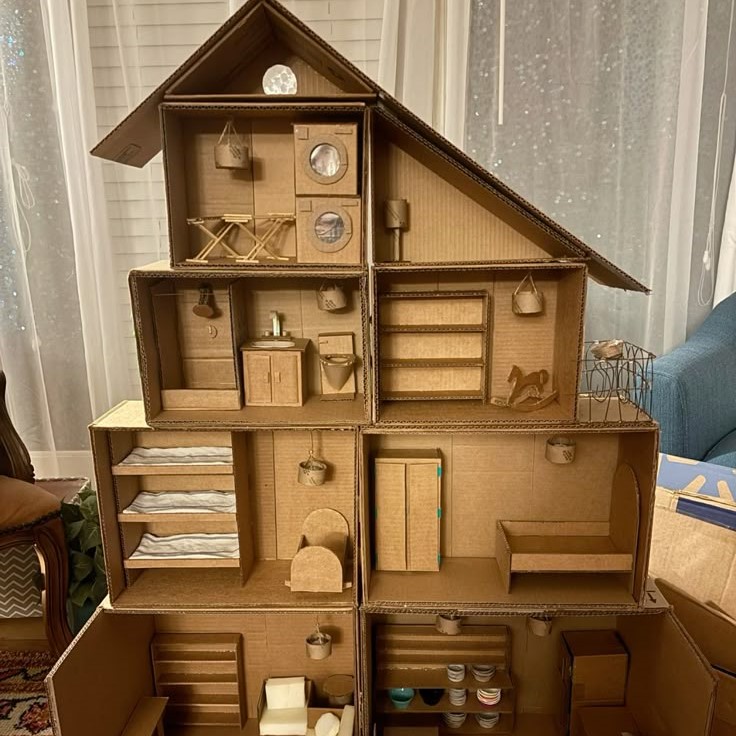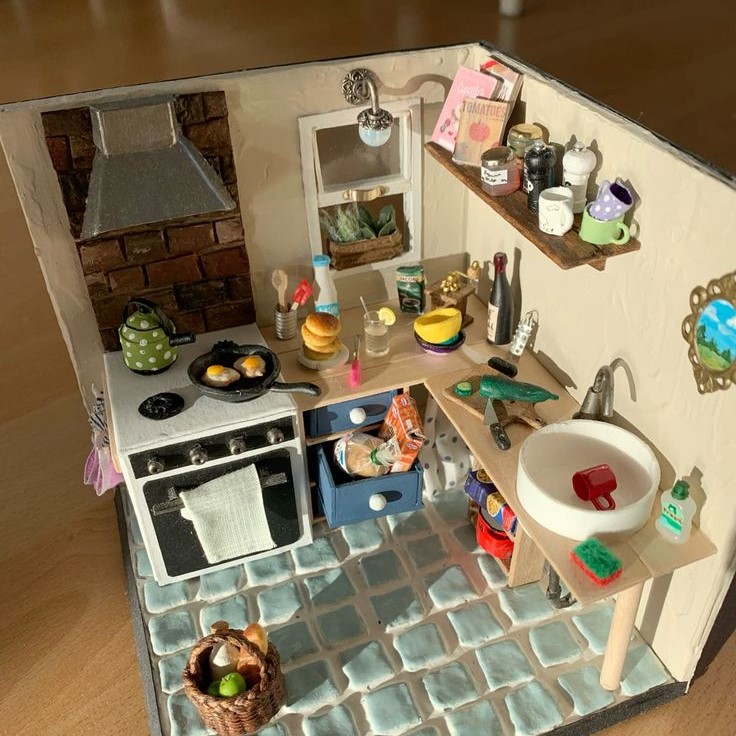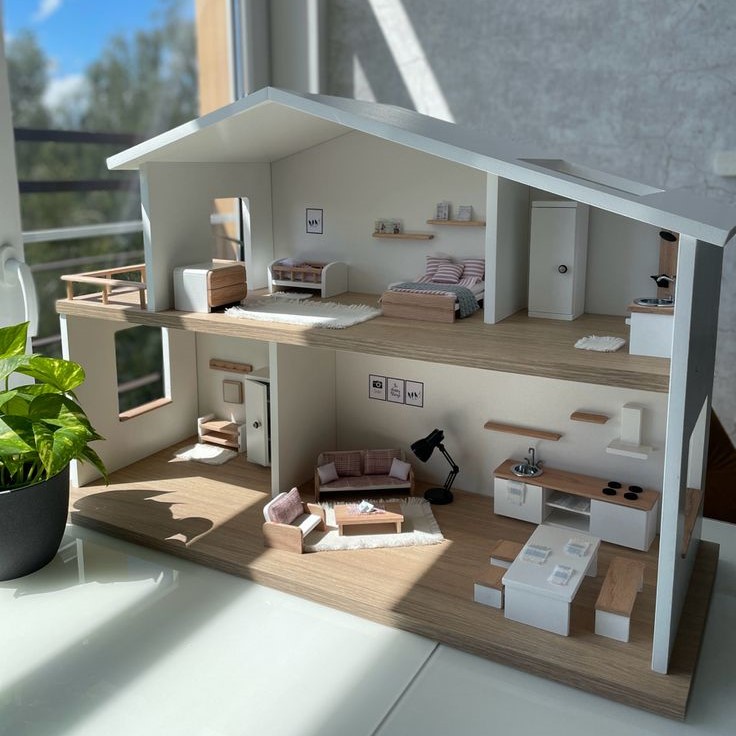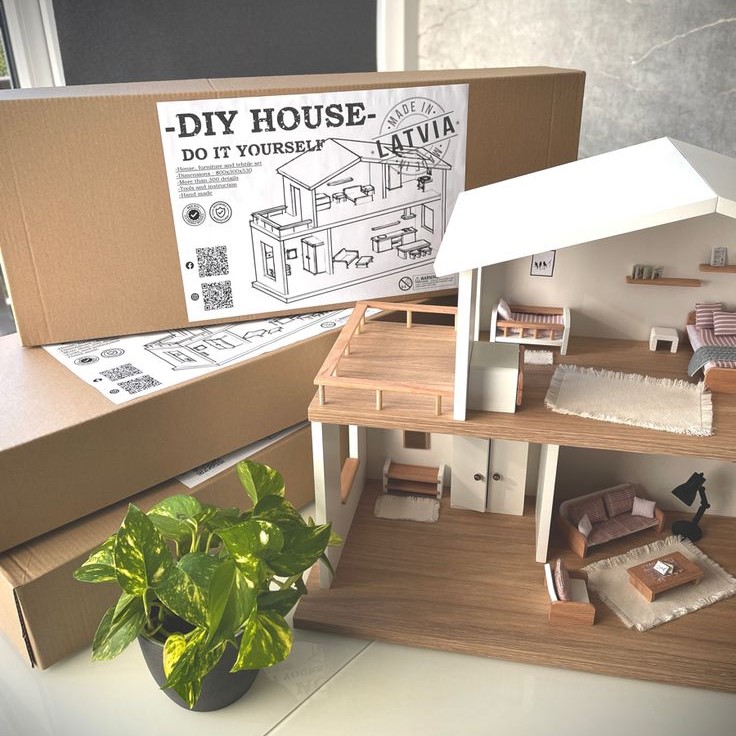Essential Tools and Materials Needed
Before you dive into crafting your miniature world, you’ll need to gather some essential tools and materials. To make your own doll house game, here’s a basic list that will set the foundation for your project:

- Measuring Tape or Ruler: Precision is key, so a good quality measuring tape or ruler is vital.
- Plywood or Foam Board: These are for the core framework of the doll house.
- Cutting Tools: X-Acto knives, scissors, and saws suited for precise cuts in wood or foam.
- Glue and Adhesives: Wood glue for structural pieces and super glue for finer details.
- Paint and Brushes: For decoration, you will need various colors and brush sizes.
- Decorative Papers or Fabrics: To add textures to floors and walls.
- Beads and Buttons: These can serve as doorknobs or other small embellishments.
Remember to work in a well-lit space and keep your tools organized. As you start making your own doll house game, having these materials ready will smooth the process and spark creativity.
Step-by-Step Guide to Building Your Doll House
Building your own doll house game can be a delightful and rewarding project. To turn this into reality, follow this step-by-step guide. Start by crafting a solid plan, then move on to the structural work, and finally, add the finishing touches.
Choosing the Right Scale and Design
Selecting the appropriate scale is crucial. It ensures that everything fits and looks proportionate. Common scales include 1:12, 1:24, and 1:48. Decide on the design and style of your doll house. Will it be a Victorian mansion, a modern apartment, or perhaps a cozy cottage? Sketch your ideas or look for templates that inspire you.
Constructing the Framework
Once your design is set, begin constructing the framework. Use plywood or foam board as per your tool set and skills. Measure and cut precisely for a sturdy base. Assemble the framework using wood glue for a robust structure. Take your time and verify every angle is correct to avoid future issues.
Adding Walls, Floors, and Ceilings
Now, add the walls, floors, and ceilings. Use decorative papers or fabrics for textures. Beads and buttons can turn into doorknobs and other tiny details. For walls and floors, paint them first if you prefer a specific color scheme. Make sure each piece fits snugly and reinforces the structure. Let your creativity guide you as you bring your doll house to life.

Customizing Furniture and Accessories
When your doll house framework stands complete, it’s time to fill it with furniture and accessories. This step truly personalizes your miniature world, bringing character and charm to each room. Every piece should reflect the overall theme and scale you chose earlier. You can create furniture from various materials like balsa wood, cardboard, or even polymer clay.
Making Miniature Furniture from Scratch
To make your own doll house game, crafting miniature furniture from scratch can be quite satisfying. Start with simple designs like tables or chairs and gradually move to more intricate pieces like cabinets or beds. Use balsa wood for an easy-to-cut option that still looks realistic. Measure twice, cut once, and assemble using a strong adhesive. For upholstery, small fabric scraps can mimic real-life textures.
Crafting Small Decorative Items
Accessories add depth to the doll house, making it look lived-in. Think of crafting items like tiny books, vases, or picture frames. These can be made from paper, beads, or even polymer clay. For example, roll paper tightly to simulate candles or cut small rectangles to stack as books. Add paint for color, and maybe use a fine-tipped pen for details like book titles. Remember to keep the scale consistent for full effect.
Incorporating Playable Game Elements
Once you have constructed your doll house and decorated it with furniture and accessories, the next step is to make your own doll house game truly playable. This means adding elements that will engage players and offer a variety of challenges and objectives.
Designing Challenges and Objectives
Begin by thinking about the storyline or scenarios for your game. Set goals for players to achieve. These could range from decorating a room within a time limit, to hosting a miniature event. Challenges can also be puzzle-like, requiring players to find hidden objects or figure out how to use certain items correctly. Think about the age group of your players and design objectives accordingly to ensure a fun and suitable gameplay experience.
Rules and Gameplay Mechanics
The rules are the backbone of any game. They should be clear, concise, and easy to follow. Decide on the turn sequence, how players will move through the doll house, and what actions they can take on each turn. You might want to include elements of chance, such as rolling dice or drawing cards, or incorporate strategy by allowing players to choose their actions. The gameplay mechanics should support the challenges and objectives you’ve designed and keep players engaged. Be creative but practical, ensuring the rules make sense for the size and scale of your doll house game. Remember, the aim is to create an enjoyable experience that will tempt players to return to your miniature world time and again.

Tips for Painting and Decorating Your Doll House
When you make your own doll house game, the aesthetic aspect plays a significant role. Here are some useful tips for painting and decorating your doll house to enhance its visual appeal and make it more engaging:
- Choose a Color Scheme: Decide on a cohesive color palette before you start painting. This ensures that your doll house has a harmonious look. For a more realistic effect, use muted tones and pastels.
- Quality Paint: Invest in good quality craft paint. It adheres better and has a superior finish, making your doll house look neat and appealing.
- Small Brushes: Use fine-tip brushes for detailed painting work. These allow greater control and precision when working on the tiny areas of furniture and walls.
- Textures: Add textures to walls and floors. Use texturing techniques like sponging or rag-rolling to give depth and character to plain surfaces.
- Wallpapers and Fabrics: Use patterned wallpapers or fabric scraps for an easy decor update. They can quickly change the look of any room without needing to paint.
- DIY Decorations: Make your own curtains, carpets, or wall art. Small craft beads can be used as wall hangings, and fabric pieces can make pretty drapes or carpets.
- Consistent Scale: Keep the scale consistent across all decorations and painting styles. This maintains the illusion of a real house.
- Natural Lighting: If possible, position your doll house near a natural light source. It emphasizes the colors and details beautifully.
These techniques will not only embellish your doll house but also upgrade the engagement level of your game. With these decor elements, players are more likely to be drawn into the tiny world you’ve created.
Inspirational Ideas from Popular Doll House Games
Drawing inspiration from popular doll house games can elevate your own creation to an exciting level. Here are some creative ideas to incorporate:
Interactive Elements
- Engaging Features: Consider incorporating interactive elements into the doll house, such as lights that can be turned on and off. This feature not only enhances realism but also adds an element of fun for players.
- Functional Doors: Include doors that can open and close, allowing players to engage more actively with the doll house. Functional doors can facilitate imaginative play, encouraging users to create their own scenarios and stories.
- Technology Integration: Explore the option of using simple electronics to power lights and other features. This tech integration can enhance the experience by making it more lifelike and interactive.
Themed Rooms
- Creative Inspiration: Draw inspiration from popular games that utilize themed rooms, transforming each space in the doll house into something unique. For example, a winter wonderland bedroom could feature snowflakes, cozy blankets, and icicle lights.
- Jungle-Themed Living Room: Consider a jungle-themed living room filled with vibrant colors, animal decor, and plant features. This themed approach can spark creativity and imagination, making each room an adventure in itself.
- Diverse Themes: Expand the range of themes to cater to different interests, such as space, underwater worlds, or fairytale castles. Each theme can offer players a chance to explore diverse environments and foster different types of storytelling.
Dynamic Characters
- Character Creation: Develop characters with rich backstories that can be integrated into the doll house game. Each character can have unique personalities, aspirations, and relationships with other characters.
- Character Interaction: Ensure that these characters can interact with each other and the doll house environment in meaningful ways. This depth adds complexity and invites players to become emotionally invested in the gameplay.
- Player Engagement: By creating characters with distinct traits and narratives, you enhance player engagement. Users may feel a stronger connection to their gameplay experience, making the doll house more immersive.
Seasonal Accessories
- Changing Decorations: Introduce the concept of seasonal accessories that players can use to change the decor of the doll house according to different seasons. For instance, colorful leaves and pumpkins for autumn or festive lights for winter holidays.
- Revisiting the Game: This feature not only adds visual appeal but also encourages players to revisit the game regularly to experience new decorations and themes corresponding to the time of year.
- Event-Based Updates: Consider introducing limited-time decorations for specific holidays or events, enticing players to return to the game for exclusive content.
Sound Effects
- Enhancing Immersion: Some doll house games benefit from adding sound effects that mimic real-life sounds. These might include door creaking, laughter, nature sounds, or ambient music that fits the theme of each room.
- Small Sound Modules: Incorporate small sound modules that can be activated through player interactions, enhancing the immersive experience. This audio element can make the gameplay more engaging and lively.
- Feedback Mechanisms: Utilize sound effects as feedback mechanisms for player actions, such as when they open a door or light a lamp, making the game feel more responsive and interactive.
Puzzle Integration
- Incorporating Puzzles: Design small puzzles that players can solve within the doll house. These puzzles could range from simple riddles to more complex challenges inspired by escape room games.
- Encouraging Exploration: By integrating puzzles into various rooms, players are encouraged to explore the doll house more thoroughly. Solving puzzles can unlock new areas or reveal hidden features, enhancing the overall gameplay.
- Interactivity and Challenge: Puzzles add a level of interactivity and challenge that can greatly enrich the gaming experience, making it more than just exploration but also problem-solving.
Storytelling Elements
- Strong Narratives: Many popular games successfully incorporate strong narratives that unfold as the player progresses. Consider adding storytelling elements that reveal more about the characters and their interactions over time.
- Milestones and Events: Implement key milestones or events that drive the story forward, allowing players to shape the narrative with their decisions and interactions within the doll house.
- Multi-Layered Stories: Develop multi-layered stories with different outcomes based on the player’s choices, enhancing replayability and encouraging deeper engagement with the doll house game.
These ideas from popular doll house games can help make your own doll house game a more vibrant and appealing project. They add layers of interaction and appeal to a broader audience. Keep these creative cues in mind as you detail your miniature world.
Maintaining and Storing Your Doll House Creation
Once you have created your own doll house game, it is important to maintain and store it properly to ensure its longevity. Here are some tips to help you take care of your miniature world:
- Clean Regularly: Dust can accumulate quickly in small spaces. Use a soft brush or a microfiber cloth to gently remove dust from the surfaces of your doll house and its contents.
- Avoid Direct Sunlight: Sunlight can fade the colors of your doll house and its decorations. Try to keep it in a spot that doesn’t get direct sun exposure.
- Control Humidity: Too much moisture can damage your doll house. Keep it in a place with stable humidity levels to prevent warping or mold.
- Secure Loose Items: Make sure that all small decorative items are securely attached. If you need to move your doll house, this will prevent items from getting lost or broken.
- Regular Inspections: Check your doll house for any signs of wear or damage. Fix any loose parts or touch up paint as needed to keep it looking its best.
- Storage Solution: When not on display, place your doll house in a storage container or cover it to protect it from dust and damage. Choose a storage location that is cool, dry, and away from heat sources.
By following these steps, you can help make your own doll house game last for years to come, bringing joy and play to many. Remember to handle it with care, and always put items back in their place after play to maintain organization and order in your miniature world.

